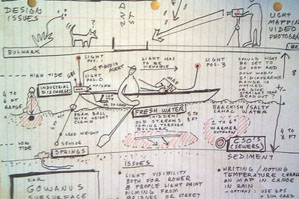Fishing for environmental justice


Sociology major Kaya Simmons developed a “thermal fishing bob” for community members to map thermal pollution in their own neighborhoods. Photo via Public Lab.
Kaya Simmons grew up in Brooklyn, that wonderful borough of bridges, bagels, the world-famous Cyclone ride…and superfund sites? In 2011, the Environmental Protection Agency took the Gowanus Canal–one of the most polluted bodies of water–under its wing. A major source of pollution, Simmons told me at the recent Pop Up lab on sustainability, is combined sewage overflow.
To understand the impact of this problem, researchers use something called a flir camera to visualize the thermal variation in a body of water. Gross as it sounds, sewage getting dumped into the canal is warmer than the water, so illegal sites can be identified using this visualization technique. The only problem is that flir cameras are ridiculously expensive (the cheapest ones are $1,000 bucks). The EPA is putting out its own flir camera results of the Gowanus Canal, but the community has no way of checking the data for itself.
“There’s not enough scientific data on a public and local community level for people to understand the actual health hazards,” said Simmons. So he decided to do something about it.
Last year, as a first-year sociology major, Simmons worked with assistant professor Sara Wylie to further develop a low-cost, do-it-yourself instrument that would allow him and his neighbors to map the thermal pollution of the Gowanus Canal themselves. The device was originally conceptualized by Wylie’s students at Rhode Island School of Design and Public Lab, an open source, DIY science site cofounded by Wylie and her colleagues.
It’s unclear where the sewage overflow sites in the Gowanus actually are, so this tool would help identify them. But what is this tool exactly? “All it is is a thermometer attached to a light which changes color,” said Wylie. “Basically what you do is you take the light and treat it as a single pixel in a picture,” she explained. Then they use the device to take a long exposure photo as they reel it in, mapping the body of water with light as they go.
The device is called a “thermal fishing bob” because it’s lightweight enough to hook onto a fishing line and throw it into the middle of the water. It collects data as you reel it back in.
The current prototype cost about $70 to develop, but Simmons and Wylie expect that number to drop to $20 or $30 once they’ve worked out all the kinks.
At that point they’ll begin selling it on Public Lab. “So anyone who wants to use it can,” said Simmons. Right now, Public Lab has all the instructions for anyone who wants to build it themselves.





